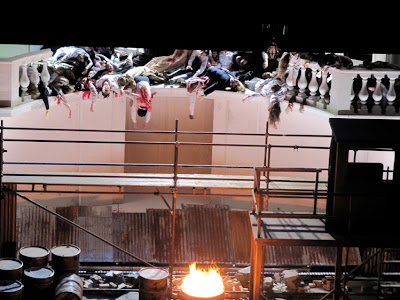music direction Lothar Koenigs
direction Guy Joosten
Klytämnestra Natascha Petrinsky
Elektra Nadine Secunde
Chrysothemis Annalena Persson
Orest Gerd Grochowski
Aegisth Donald Kaasch
direction Guy Joosten
Klytämnestra Natascha Petrinsky
Elektra Nadine Secunde
Chrysothemis Annalena Persson
Orest Gerd Grochowski
Aegisth Donald Kaasch
I never miss the opportunity to express my praise for Peter de Caluwe, the young and very talented intendant of La Monnaie/De Munt, who with a comparably small budget manages to make wonderful [co-]productions, thus assuring the global excellent level of artistic quality [so much better than what's currently being done in its much richer counterpart - Opéra National de Paris]. Last year we saw there the phenomenal production of Le Grand Macabre (which was the coproduction with GT Liceu, ENO and Opera di Roma) with the fantastic young British conductor Leo Hussain. This year they offers us Elektra co-produced with GT Liceu where it was premiered last year.
I wanted to see this Elektra because of Guy Joosten, whose productions I usually like, and because of the wonderful cast (Evelyn Herlitzius, Eva-Maria Westbroek, Doris Soffel). When I was making my travel plans that cast-A was indeed scheduled for this Sunday --January 31, 2010-- but for some reason they reshuffled the sched and we ended up with Cast-B, the one listed above in red.
Joosten transposed Elektra to a 20th century military regime -- dictatorship. It is not clear which one, and it doesn't really matter. It's enough to suggest that Aegisth and Klytaemnestra rule after a coup in which they killed Elektra's father Agamemnon...
You get the military association from the get-go but implicitly, namely with the servants changing in the lockers, putting their uniforms on. We then discover Elektra in the backyard of the palace in which the banquet will take place (the banquet you see only implicitly again, via the guests and servants coming in and out). The scaffoldings and the staircase are the dramatic and decorative accessories to make the place look like... like a backyard. So there lives Elektra consumed by her rage and her insatiable desire for revenge - to see dead those who killed her father. Orest will eventually come in the military uniform and do the job: Joosten decides to lift the walls of the palace in the end to show us a pile of massacred dead bodies. Boy was Orest busy killing ;)
The Last Scene...
Interestingly, in this production the ecstatic Elektra does not perform her famous dance. She instead stays almost like paralyzed: her only purpose to live was this revenge, and once it's done her life has no sense any more -- she's "lost/paralyzed". Good eh?! ;)
Note that this doesn't contradict the libretto at all (Elektra indeed says she couldn't move). It suffices to read it carefully...
The psychological tension in the relationship between Elektra and Klytaemnestra is perfectly sculpted. You could see the swings of mood happening on stage, and eventually Klytaemnestra terrified by the idea that she might be one to perish. She starts to laugh insanely at that point -- very plausible reaction to fight your fear or at least when trying to save your appearance!-- which makes Elektra not only puzzled but even more desperate (she does not know at that point whether Orest is alive or not).
The relation Elektra-Chrysothemis is deftly built in too [the detail with suitcases and the doll was interesting: which I would have missed if I didn't listen to the 30min long presentation of the production before the actual show].
The orchestral part was OK. Maybe not really the top in the genre, but Lothar Koenigs does a good job. It's maybe my personal taste but I like that fear and tension in the music for this opera, and the monumental orchestral waves coming to bury you. That latter point was missing this Sunday in Brussels.
As for the singers, to me, the best was the Swedish soprano Annalena Persson who I already liked in that highly controversial Konwitschny's Salome, and Gerd Grochowski (whose Telramund in the Herheim's production of Lohengrin was excellent). Nadine Secunde is not my cup of tea, but you must congratulate the woman for her stamina and her vocal volume: she never got in trouble or risked to get drowned by the Orchestra (I know that this compliment is to be shared with Lothar Koenigs, but Nadine deserves it too).
Here are your servants in uniforms
Persson and Secunde
A scary/creepy looking Orest by Gerd Grochowski
More pics can be found on the La Monnaie website






Interesting review.
ReplyDeleteThe whole performance can be heard on-line if you visit La Monnaie home page. Can't seem to post a link.
Can't find it :(
ReplyDeleteBut thanks anyway :)
ReplyDeleteUnder news on the Home page. There is a prominent picture of a lady with an axe, so that's a bit of a giveaway.
ReplyDeleteOf course, it had to be that obvious ;)
ReplyDeleteThanks!